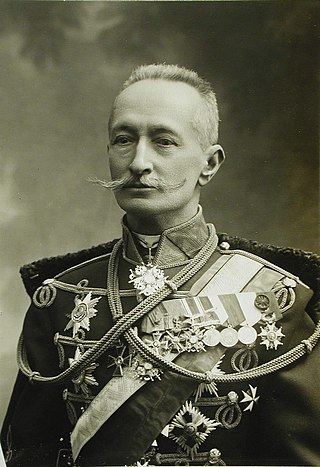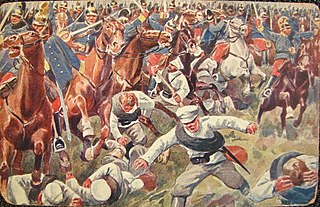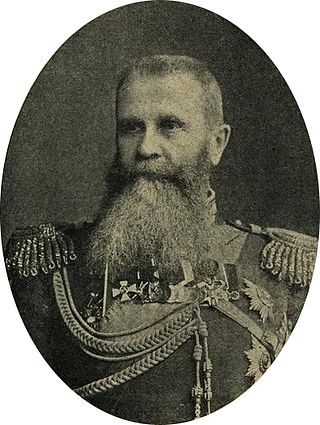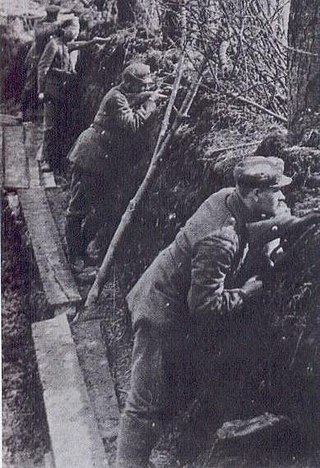
The Brusilov offensive, also known as the "June advance", of June to September 1916 was the Russian Empire's greatest feat of arms during World War I, and among the most lethal offensives in world history. The historian Graydon Tunstall called the Brusilov offensive the worst crisis of World War I for Austria-Hungary and the Triple Entente's greatest victory, but it came at a tremendous loss of life. It was arguably the most successful offensive in the entirety of the First World War. The victory contributed to a morale upsurge among the Russian troops, in 1917, Nicholas II planned a general general offensive along the entire front in order to end the Central Powers. After the victory, the Petrograd conference was held at which the post-war structure of the world was discussed.

The Battle of Łódź took place from 11 November to 6 December 1914, near the city of Łódź in Poland. Battles were fought between German units of the Eighth army, Ninth Army, Austrian First Army, and the Russian First, Second, and Fifth Armies, in harsh winter conditions. The Germans redeployed their Ninth Army around Thorn, so as to threaten the Russian northern flank, following German reversals after the Battle of the Vistula River. The German objective was to prevent an invasion of Germany, by encircling and destroying the Russians, as a result, Germans themselves were surrounded and actually lost 2 corps, although the invasion of Germany was prevented Battle had a strong impact on both the Western and Eastern fronts. It ended with the victory of the Russian troops, although the planned invasion of Germany was canceled

Aleksei Alekseyevich Brusilov was a Russian and later Soviet general most noted for the development of new offensive tactics used in the 1916 Brusilov offensive, which was his greatest achievement.
The 1st Army was a field army-level command in the ground forces of Austria-Hungary during World War I. The army fought in Galicia and Russian Poland in 1914–15 before being briefly dissolved in the summer of 1916. Shortly afterwards, it was reformed and sent to fight in the Romanian Campaign for the next two years. The 1st Army was demobilized in April 1918 due to its heavy losses, following Romania's surrender.

The Battle of the Vistula River, also known as the Battle of Warsaw, was a Russian victory against the German Empire and Austria-Hungary on the Eastern Front during the First World War.

The Battle of Kraśnik started on August 23, 1914, in the province of Galicia and the adjacent areas across the border in the Russian Empire, in northern Austria, and ended two days later. The Austro-Hungarian First Army defeated the Russian Fourth Army. It was the first victory by Austria-Hungary in World War I. As a result, the First Army's commander, General Viktor Dankl, was (briefly) lauded as a national hero for his success. The battle was also the first of a series of engagements between Austria-Hungary and Russia all along the Galicia front.

The Gorlice–Tarnów offensive during World War I was initially conceived as a minor German offensive to relieve Russian pressure on the Austro-Hungarians to their south on the Eastern Front, but resulted in the Central Powers' chief offensive effort of 1915, causing the total collapse of the Russian lines and their retreat far into Russia. The continued series of actions lasted the majority of the campaigning season for 1915, starting in early May and only ending due to bad weather in October.

Nikolai Iudovich Ivanov was a Russian artillery general in the Imperial Russian Army. In July 1914, Ivanov was given command of four armies in the Southwestern Front against the Austro-Hungarian army, winning a major battle of Galicia. During the Russian Revolution of March 1917, Tsar Nicholas II ordered Ivanov to suppress the revolutionaries but as promised reinforcements failed to come to his aid, he canceled the aborted mission. In 1917, he retired but a year later took command of the White Army. In 1919, Ivanov died of typhus in Southern Russia.

The Battle of Limanowa-Łapanów took place from 1 December to 13 December 1914, between the Austro-Hungarian Army and the Russian Army near the town of Limanowa.

Battle of Rawa was an early stage World War I battle between Austria-Hungary and Russia, from 3-11 September, 1914. The Russian armies had defeated their opponents and pushed them back to the Carpathian mountains. The battle was part of the series of engagements known as Battle of Galicia.

Nikolai Vladimirovich Ruzsky was a Russian general, member of the state and military councils, best known for his role in World War I and the abdication of Tsar Nicholas II.

The Battle of Kostiuchnówka was a World War I battle that took place July 4–6, 1916, near the village of Kostiuchnówka (Kostyukhnivka) and the Styr River in the Volhynia region of modern Ukraine, then part of the Russian Empire. It was a major clash between the Russian Army and the Polish Legions during the opening phase of the Brusilov Offensive.

The Rovno offensive — the operation of the Austro-Hungarian Northern armies against the armies of the Russian Southwestern Front — the so-called campaign on Rovno, or Lutsk-Rovno offensive operation. The purpose of the offensive was the liberation of Eastern Galicia, but by the end of the operation, a small part of Eastern Galicia was still held by the Russian Imperial Army.

The Battle of Komarow was a battle on the Eastern Front during World War I. It would prove a victory for the Austro-Hungarian forces, but one they would not be able to reproduce in the coming months of the war.

The Southwestern Front was an army group of the Imperial Russian Army during World War I as part of the Eastern Front war theater.

The Battle of Gnila Lipa took place in early World War I on 29–30 August 1914, when the Imperial Russian Army invaded Galicia and engaged the defending Austro-Hungarian Army. It was part of a larger series of battles known collectively as the Battle of Galicia. The battle ended in a defeat of the Austro-Hungarian forces.

Paul Freiherr Puhallo von Brlog was a general of Austria-Hungary. During World War I, he commanded the Austro-Hungarian Army's 3rd and 1st Armies.
The 3rd Army was a field army-level command within the ground forces of Austria-Hungary during World War I. It was primarily active on the Eastern Front against the Russian Empire and in the Balkans against Serbia and Montenegro. Later on, the 3rd Army took part in some fighting on the Italian Front before returning to the eastern theater by 1917 to repulse the Kerensky Offensive. Its remaining units were merged with the 7th Army in January 1918.

The Carpathian Front, sometimes referred to as the Carpathian Winter War, of 1915 was one of the largest military operations on the Eastern Front at 1915 in terms of scale, duration, the number of troops involved in it and the losses of the parties.

The Battle of Dniestr and Zolota Lypa was an inconclusive battle between the armies of Austria-Hungary and the Russian Empire during the summer offensive of the Central Powers in 1915.

















